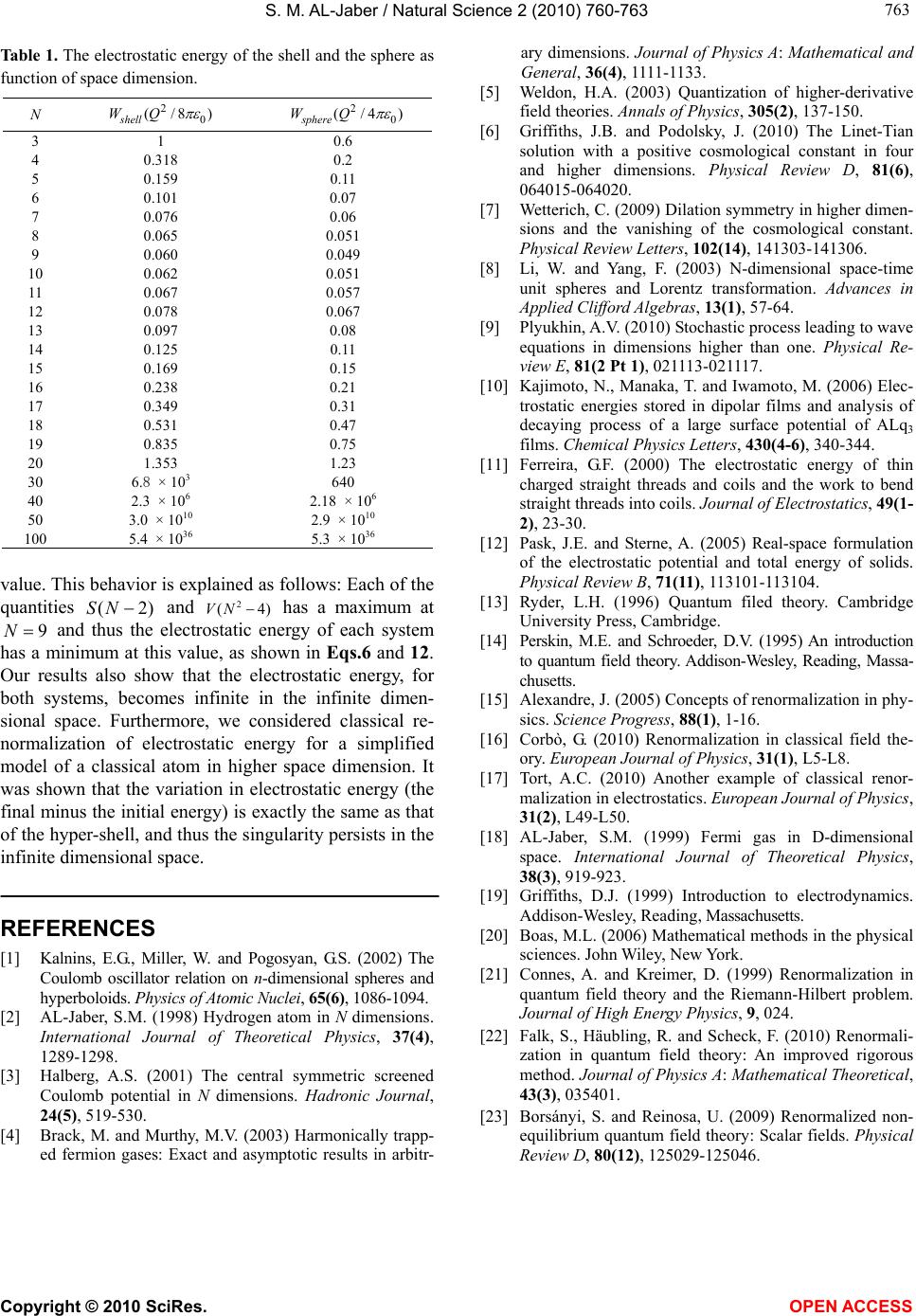
S. M. AL-Jaber / Natural Science 2 (2010) 760-763
Copyright © 2010 SciRes. OPEN ACCESS
763
763
Table 1. The electrostatic energy of the shell and the sphere as
function of space dimension.
N 2
0
(/8)
shell
WQ
2
0
(/4)
sphere
WQ
3
4
5
6
7
8
9
10
11
12
13
14
15
16
17
18
19
20
30
40
50
100
1
0.318
0.159
0.101
0.076
0.065
0.060
0.062
0.067
0.078
0.097
0.125
0.169
0.238
0.349
0.531
0.835
1.353
6.8 × 103
2.3 × 106
3.0 × 1010
5.4 × 1036
0.6
0.2
0.11
0.07
0.06
0.051
0.049
0.051
0.057
0.067
0.08
0.11
0.15
0.21
0.31
0.47
0.75
1.23
640
2.18 × 106
2.9 × 1010
5.3 × 1036
value. This behavior is explained as follows: Each of the
quantities )2( NS and 2
(4)VN has a maximum at
9N and thus the electrostatic energy of each system
has a minimum at this value, as shown in Eqs.6 and 12.
Our results also show that the electrostatic energy, for
both systems, becomes infinite in the infinite dimen-
sional space. Furthermore, we considered classical re-
normalization of electrostatic energy for a simplified
model of a classical atom in higher space dimension. It
was shown that the variation in electrostatic energy (the
final minus the initial energy) is exactly the same as that
of the hyper-shell, and thus the singularity persists in the
infinite dimensional space.
REFERENCES
[1] Kalnins, E.G., Miller, W. and Pogosyan, G.S. (2002) The
Coulomb oscillator relation on n-dimensional spheres and
hyperboloids. Physics of Atomic Nuclei, 65(6), 1086-1094.
[2] AL-Jaber, S.M. (1998) Hydrogen atom in N dimensions.
International Journal of Theoretical Physics, 37(4),
1289-1298.
[3] Halberg, A.S. (2001) The central symmetric screened
Coulomb potential in N dimensions. Hadronic Journal,
24(5), 519-530.
[4] Brack, M. and Murthy, M.V. (2003) Harmonically trapp-
ed fermion gases: Exact and asymptotic results in arbitr-
ary dimensions. Journal of Physics A: Mathematical and
General, 36(4), 1111-1133.
[5] Weldon, H.A. (2003) Quantization of higher-derivative
field theories. Annals of Physics, 305(2), 137-150.
[6] Griffiths, J.B. and Podolsky, J. (2010) The Linet-Tian
solution with a positive cosmological constant in four
and higher dimensions. Physical Review D, 81(6),
064015-064020.
[7] Wetterich, C. (2009) Dilation symmetry in higher dimen-
sions and the vanishing of the cosmological constant.
Physical Review Letters, 102(14), 141303-141306.
[8] Li, W. and Yang, F. (2003) N-dimensional space-time
unit spheres and Lorentz transformation. Advances in
Applied Clifford Algebras, 13(1), 57-64.
[9] Plyukhin, A.V. (2010) Stochastic process leading to wave
equations in dimensions higher than one. Physical Re-
view E, 81(2 Pt 1), 021113-021117.
[10] Kajimoto, N., Manaka, T. and Iwamoto, M. (2006) Elec-
trostatic energies stored in dipolar films and analysis of
decaying process of a large surface potential of ALq3
films. Chemical Physics Letters, 430(4-6), 340-344.
[11] Ferreira, G.F. (2000) The electrostatic energy of thin
charged straight threads and coils and the work to bend
straight threads into coils. Journal of Electrostatics, 49(1-
2), 23-30.
[12] Pask, J.E. and Sterne, A. (2005) Real-space formulation
of the electrostatic potential and total energy of solids.
Physical Review B, 71(11), 113101-113104.
[13] Ryder, L.H. (1996) Quantum filed theory. Cambridge
University Press, Cambridge.
[14] Perskin, M.E. and Schroeder, D.V. (1995) An introduction
to quantum field theory. Addison-Wesley, Reading, Massa-
chusetts.
[15] Alexandre, J. (2005) Concepts of renormalization in phy-
sics. Science Progress, 88(1), 1-16.
[16] Corbò, G. (2010) Renormalization in classical field the-
ory. European Journal of Physics, 31(1), L5-L8.
[17] Tort, A.C. (2010) Another example of classical renor-
malization in electrostatics. European Journal of Physics,
31(2), L49-L50.
[18] AL-Jaber, S.M. (1999) Fermi gas in D-dimensional
space. International Journal of Theoretical Physics,
38(3), 919-923.
[19] Griffiths, D.J. (1999) Introduction to electrodynamics.
Addison-Wesley, Reading, Massachusetts.
[20] Boas, M.L. (2006) Mathematical methods in the physical
sciences. John Wiley, New York.
[21] Connes, A. and Kreimer, D. (1999) Renormalization in
quantum field theory and the Riemann-Hilbert problem.
Journal of High Energy Physics, 9, 024.
[22] Falk, S., Häubling, R. and Scheck, F. (2010) Renormali-
zation in quantum field theory: An improved rigorous
method. Journal of Physics A: Mathematical Theoretical,
43(3), 035401.
[23] Borsányi, S. and Reinosa, U. (2009) Renormalized non-
equilibrium quantum field theory: Scalar fields. Physical
Review D, 80(12), 125029-125046.